Armenian News
Network / Groong
A Rare Poster of
an Armenian Boy Used in Fund Raising for the Near East Relief: rare because
very few of these posters exist, and still fewer of any of the ‘NER posters’ depict
a “real Armenian”
Armenian News
Network / Groong
September 15, 2017
Special to Groong by Abraham D.
Krikorian and Eugene L. Taylor
Long Island, NY
Introduction
Throughout our efforts
aimed at achieving ever-greater precision in attestation and attribution of
photographs and imagery as they relate to the Armenians massacres, persecutions
and Genocide, we have made a special effort to verify what a photograph or
image represents (attest it) and to identify it if possible with a person,
place or time (attribute it).[1]
We have pointed out several
times that this is not an easy objective to fulfill but it seems the only way
to ‘get it right’. For us, ‘getting
it right’ means not making a mockery of so serious a topic by depicting and portraying
massacres and genocide and the consequences with materials that are not
attested or attributed properly. We
all too often encounter wrongly attested and attributed photographs and images in
articles, books, video presentations and films.[2]
In addition to attesting and
attributing photographs to the fullest extent possible, we have routinely made
special efforts to connect and integrate the images with the human element. This means we have underscored where
possible that real people were involved – not just some abstract objects.
If there is no presentation of
a real human connection, the task set forth inevitably devolves into an
exercise of cataloging for viewing outside a critical context. Showing of images of various sorts
without a context that is as accurate and detailed as possible, or merely showing
images of various sorts that might certainly catch the eye, amounts, we would
argue, to a “golly, dear me or gee whiz approach”. In scientific language, this approach would
be called a taxonomy, or ordered classification, perhaps not
even an accurate or good taxonomy.
But how does one decide on the
categories into which one should classify?
Topic, time frame, degree of gruesomeness, and so on - we need not
concern ourselves with that point. It
is of interest though that we have, for instance, seen catalogs that emphasize primarily
price and availability of posters – hardly a scholarly, educational
perspective in our view but valuable from the perspective of those who seek to market
period posters.[3]
Real Armenians versus Imagined
Armenians or Idealized Armenians in
Posters put out by the Near East Relief organization and its Predecessors[4]
Many, indeed most,
readers of this posting will be familiar with the array of posters used for
fund raising for Armenians and others after 1915. Intermittent efforts have been made to
provide what we refer to as a random presentation of posters (mainly American-produced)
that were used to generate interest in what was happening to the Armenians and
to aid in solicitation of funds for remnants of an essentially destroyed nation.[5]
The objective was of course to have
these posters serve as mainstays in appealing for financial and other aid to
help survivors – especially children but also adults, particularly mothers
of young children (Fig. 1).

Fig. 1
Social history has become ever-more textured over the years. We have seen the invention of terms like
“humanitarian photography” and “humanitarian art” or “art of humanitarian
action” to serve as a device for framing the many kinds of visuals associated
with fundraising. Nowadays, we are
told that these to us cumbersome phrases, are supposed to serve as umbrellas
for the broad range of imagery (and slogans) aimed at eliciting a “compassionate
response” from viewers/donors at as many levels as possible.
Many scholarly papers, and even
books, have been written on this topic.
It seems to constitute a subdiscipline in social history itself, but
only a few efforts seem to concentrate on appeals made for aid to victimized Armenians. We need not focus here on the merits or
demerits of the selection and use of certain kinds of photographs and imagery
for fundraising. Neither do we want
to attempt to address the value of various approaches for eliciting real
concern for human welfare. “Whatever works best” might well be the most
accurate answer. “Nothing succeeds
like success!?”
Even so, it has always seemed
to us that the majority of relief fund-raising posters from that period are not
very authentic – at least by current standards. And for those of us who like to think that
we “know” what Armenians are “supposed to look like”, they are considerably off
the mark. As a friend once said,
the poster drawings seem to present individuals who look like they popped out of
a children’s book or in one case, a glamor magazine. (More on that point in a different
posting.) There are exceptions of
course and this ‘paper’ deals with one of them.
Again, we will not enter into
an argument or discussion relating to what a “real Armenian” or specifically a
desperately needy Armenian at that, is supposed to look like.[6] Some readers will hopefully know what we
are alluding to.
Admittedly, all of these
posters aimed at fund-raising for humanitarian relief were released at a time
when imagery and presentation techniques were decidedly different from what one
encounters today. A glance at
period magazines will show how different the approach to advertising or
advocacy in general was way back then.
Against this broad background,
we wish to emphasize that researchers like us only very rarely encounter visual
materials, especially printed ones like posters, that
are accompanied with enough textual material to enable one to ‘pick up the
ball’ so to speak and extend the research to the next level.
We develop the story at some
considerable length in this paper since we first encountered the image in a
newspaper advertisement, and only then were we able to track down a poster
related to it. The printed poster
itself, intended for use in settings such as the one shown in Fig. 1 did not
have any text accompanying it. Had we
encountered a poster first, then we might not have been
stimulated to peruse newspapers and magazines of the period. It was surely fortuitous that we found
the ad first, and that led us to tracking down the poster. And, again we emphasize, even as we write,
that we have never seen the real poster with our own eyes.
A Poster Which Fulfills Many Important Desirables
‘Our poster’ fulfills
all our requisites or desiderata. We know that the child is Armenian. We know where the photograph was taken, but
we don’t know where the lad was originally from. We know the person who took the
photograph on which the poster was based, and we know the narrow time frame
when it was taken. We know the
circumstances under which the photograph was taken. We lack the name of the child. This is a pity but the photographer did
not know Armenian and seems not to have had a translator accessible to him at
the time.
The image of the young lad on
the poster is touching, even heart breaking. He definitely qualifies as the
proverbial “poster child” and we believe that he would surely serve admirably
in soliciting funds and support for the desperately needy such as himself. Despite his obvious state of
destitution, he maintains, we believe, a level of human dignity and pride. He does not appear to be devoid of all
hope. He does deserve “a chance.”
Presentation
of the Poster and Related Imagery in an ‘Orderly Fashion’
The series of photographs
that follow are arranged, along with captions, in a way so as to provide a
feeling for how the story developed.
As stated above, we encountered the ‘poster’ first in the form of a
newspaper ad.
If one looks through U.S. newspapers
starting around November 1919, one encounters a number of entries from the Near
East Relief captioned “Burlap Bag His Only Garment.” [7] See Fig. 2 below.
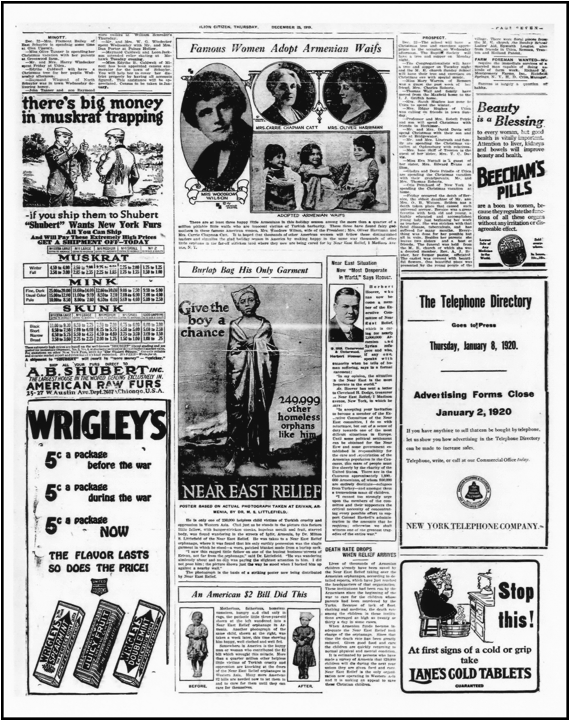
Fig. 2
From
the Ilion Citizen [Ilion, New York] December 28, 1919 page 7.
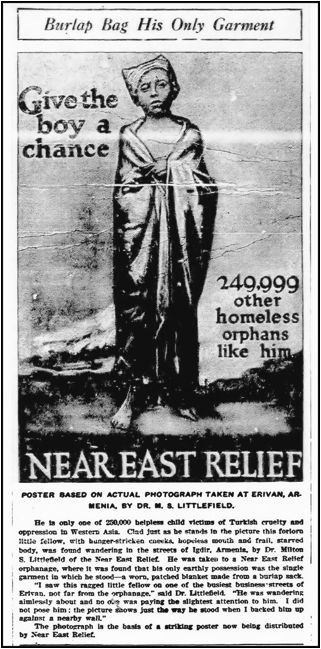
Fig. 3
Enlargement
reproduced from one of the many newspapers that included this Near East Relief
ad soliciting funds.
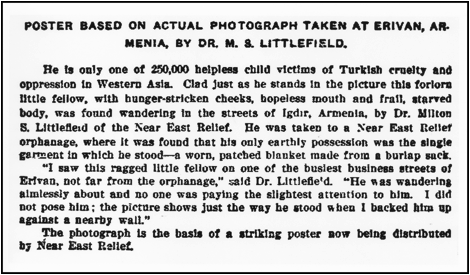
Fig. 4.
An
enlargement of the description in Fig. 3.
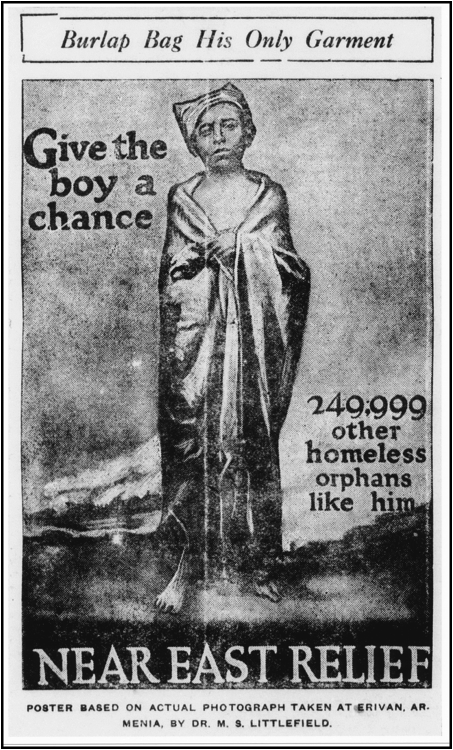
Fig. 5
An
enlarged image (without the caption) from a different newspaper.
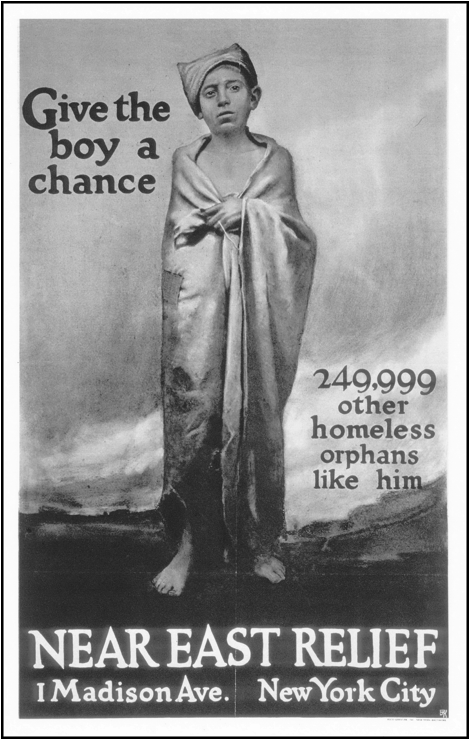
Fig. 6
High
resolution scan of the poster in the Hoover Institution collection at Stanford
University.
Poster
Collection 3577. Dimensions 33.5 cm
X 85 cm (22 X 33.5 inches).
Printed
by Alco-Gravure, Inc., New York and Baltimore (no date).
Made
available through the kind help of Hoover Institution Archives.
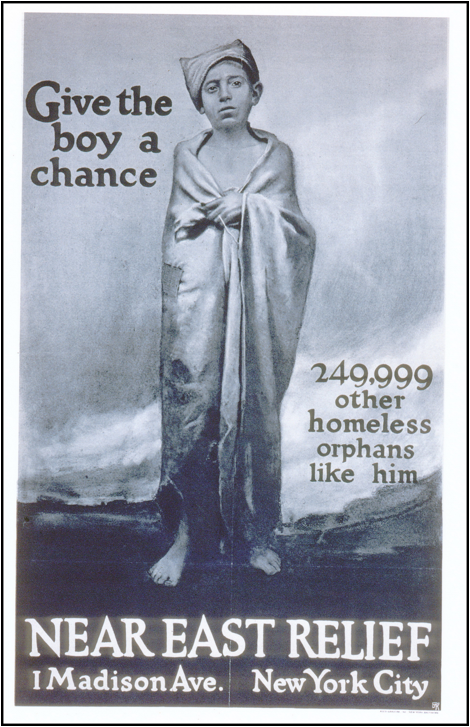
Fig. 7
High
resolution scan of poster in the Hoover Institution collection at Stanford
University.
Poster
Collection 3577. This print might well be closer to the initial color of the
poster when it was first released.
Again
we emphasize that we have never seen an original of this poster.[8]
The
next two images, Fig. 8 and Fig. 9, show early use of the photograph around the
time it was made into a poster for Near East Relief.
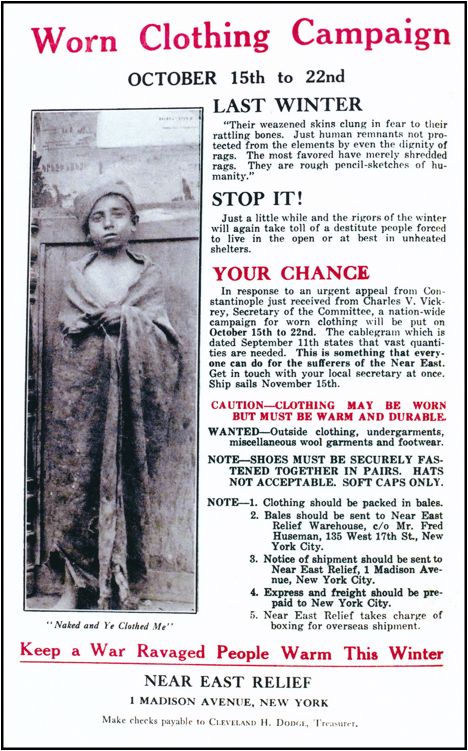
Fig. 8
From back page of New Near East vol. 4 no. 7, total number 31 (January 1920).
Photograph
taken by us at the University of Wisconsin Special Collections and Archives.
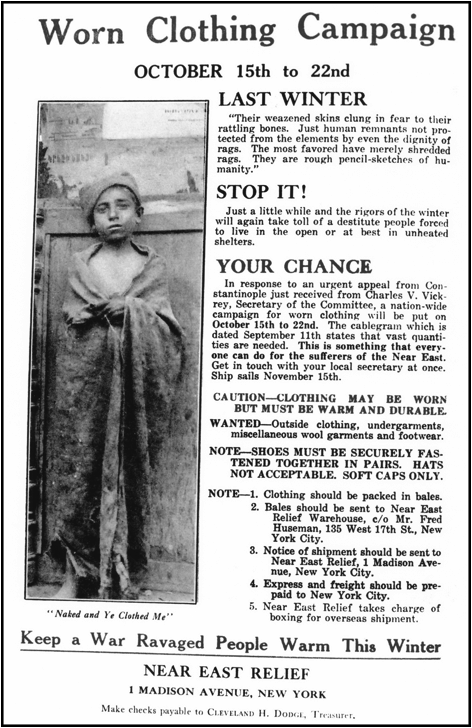
Fig. 9
Black and white version of Fig. 8.
Appeared
in The New Near East volume 4, number 1, total number 25
(June 1919).
Photograph
taken by us at University of Wisconsin Special Collections and Archives.
This black
and white image appeared some 6 months earlier than the one with some red typeset.
Clearly, the photograph had only recently been brought back by Rev. Dr.
Littlefield.
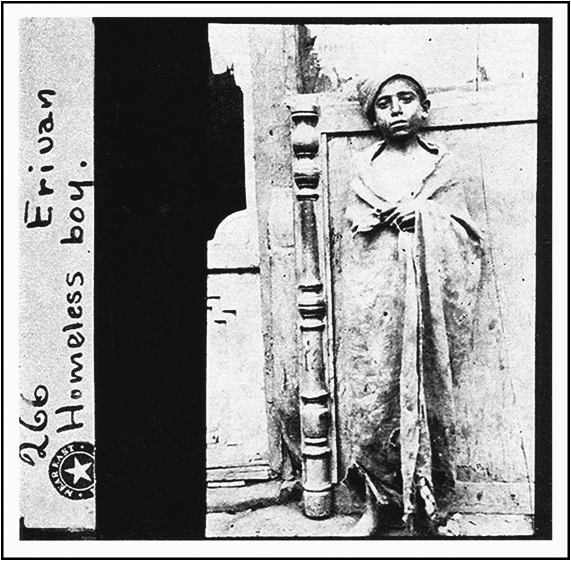
Fig. 10
From
an image taken from a glass lantern slide.
This
was reproduced in the Armenian translation of Maria Jacobsen’s Diary,
“Oragrut’iwn, 1907-1919: Kharberd.”
(1979)
T’paran Kat’oghikosutean Hayots Metis Tann Kilikioy.
The
photographs in that volume are unpaginated.[9]
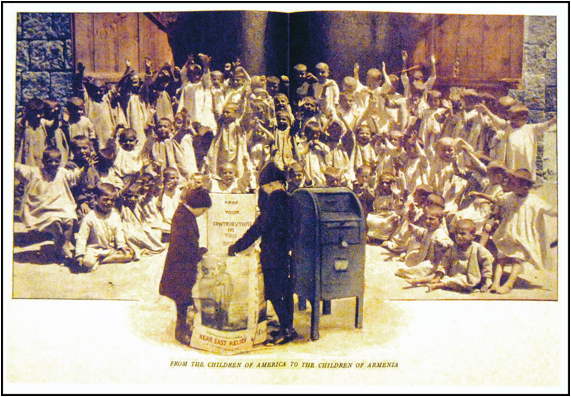
Fig. 11
From a double page spread in The New
Near East June 1920.
Photograph
taken by us at the Minnesota Historical Society Library.[10]
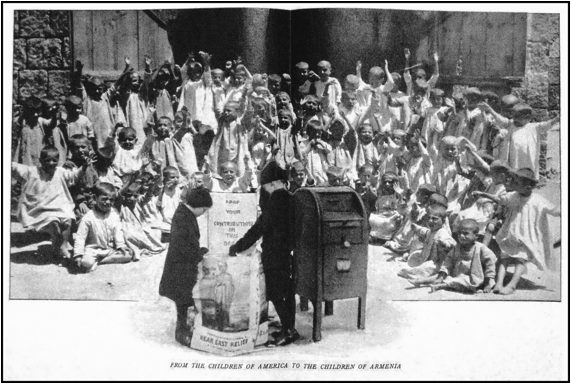
Fig. 12
Photograph
(Fig. 11) “desaturated” using Photoshop.
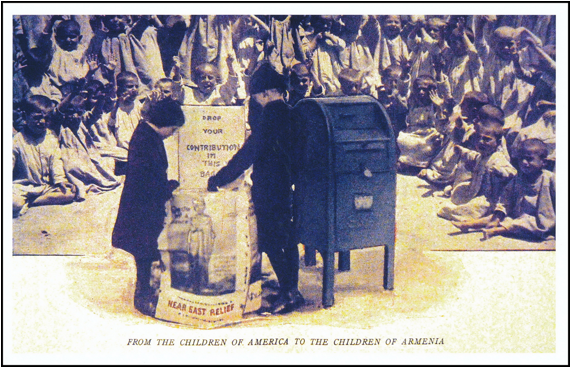
Fig. 13
Close-up
from Fig. 11.
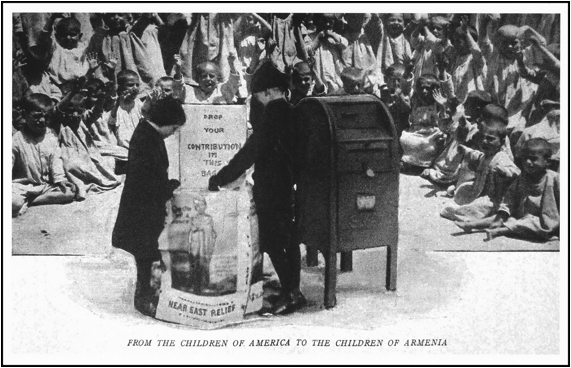
Fig. 14
Desaturated
using Photoshop.
So far, we have said virtually
nothing about the person who we believe personally took the photograph, namely
Reverend Milton Smith Littlefield, D.D.
The legend in the printed advertisement of course tells his story but it
does not tell us that he was born in New York City on August 21, 1864. His father was a lawyer. He attended schools in Florida and
Morristown, New Jersey. As a young
man Milton S. Littlefield, Jr. studied Greek and Latin especially in
preparation for the ministry at Johns Hopkins University in Baltimore as a
special student for two years (1887-1889).
He received his bachelor’s degree in 1892 from Union Theological
Seminary in New York. His Doctor of
Divinity degree was honorary and was bestowed upon him in 1915 by Washburn
College (now Washburn University in Topeka, Kansas.) He died on June 11, 1934 in his
seventieth year. He was especially
well-known for his Sunday school work and his work in hymnology.[11]
The photograph
below show Rev. Littlefield in the group that went to the Near East.
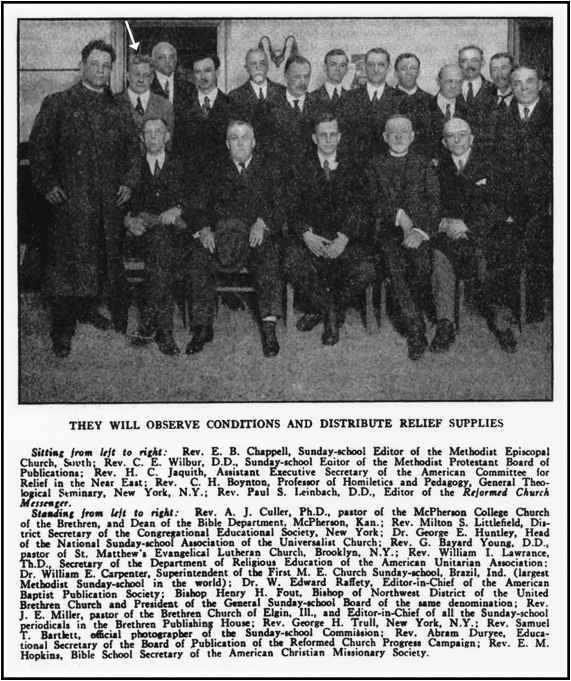
Fig. 15
Sunday-school
Commission members posed as a group.
Printed under the article heading
“Commission Goes to the Near East.”
The
white arrow points to Rev. Dr. Milton Smith Littlefield.
From
The Christian Register vol. 98 no. 4
April 3, 1919 pg. 332.[12]
Not much more need be said of
Dr. Littlefield except that he did indeed visit the Caucasus and no doubt saw
much human misery that fully engaged him to take up the task of speaking out
and promoting fund-raising for the Armenians when he returned to the United
States.
Gertrude Anthony,
was a relief worker from Oakland, California who wrote a particularly
interesting letter dated 26 December 1919 – from Erivan, Caucasus that we
have read at the Archives at UC Berkeley.
In it she describes the arrival of
the Sunday School Commission, Mr. Jaquith of the New York A.C.R.N.E. [American
Committee for Relief in the Near East], Dr. Littlefield + Dr. Boynton of New
York and Mr. Catchpool of England [Lord Mayor’s Fund in Erivan], the men who came across the Black Sea with
us. It was a “marcy” [mercy], they
came since the English-speaking man at the head of the Relief Work was out of
town and the orphanage man, Dr. Bagdasarian, had not quite so many German words
as I had. …Dr. Littlefield insisted on our going out to see the refugees and get
some pictures first. Miss
Anthony goes on, “By this time there were
groups getting breakfast, - not much but flour and water gruel with sometimes,
a few greens gathered along the river.
Those who had any possessions at all had a copper-kettle to cook in, and
some had considerable quantities of bedding packed in the native trunks which are big woven cases. But there were many, oh so many, who had
nothing, sleeping in the sun, sitting stupidly gazing about, hunting for and
chewing mustard stems. A few bought
pitiful bits of black bread from dirty peddlers squatted along the [railroad]
track.”[13]
Even though Gertrude Anthony’s
letter is dated December 26, 1919, what she writes makes it clear that she has
not had time to write often and that the whole of the letter represents a
conglomerate of the events she experienced over a long period. By checking the newspapers of the day,
we learned that Dr. Littlefield was back in the United States and was giving fund-raising
talks well before December. According
to Ellis Island Immigration data base he returned to
New York from Copenhagen on Tuesday July 15, 1919 on the S.S. United States. He was 54 years old. A notice in an Asbury Park, New Jersey
newspaper describes him as “just returned from Armenia” and addressing the
class and presenting diplomas to the graduates of the New Jersey School of
Methods, conducted by the state Sunday school association on the very next day,
Wednesday July 16! [14]
Thus, we can safely roughly
date the photographs as having been taken by Dr. Littlefield or someone with
him in the warmer time of year - spring of 1919.
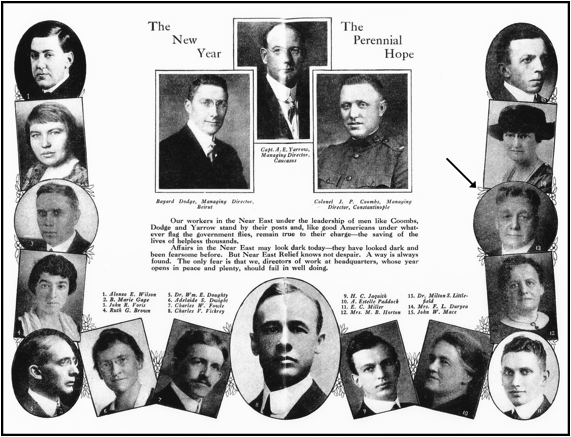
Fig. 16
Two-page
spread that shows Dr. Milton S. Littlefield (number 13 on the right hand side,
3rd
face down, marked with a black arrow).
From The
New Near East vol.6, no. 4 January 1921 pgs. 16 and 17.
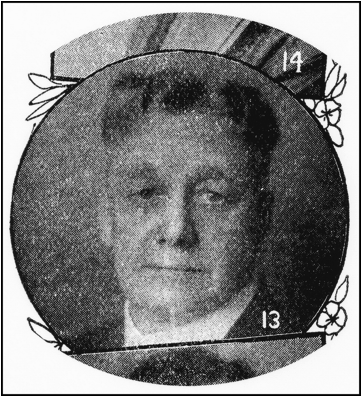
Fig. 17
Enlargement
of Dr. Littlefield from Fig. 16.
Final Commentary
The story of the poster should now
be fairly clear since we have taken pains to develop the associated story in considerably
more detail than might otherwise be thought necessary. We may surely date the photograph from
which the poster derives as spring of 1919. It was taken in Erivan since Dr.
Littlefield describes encountering the lad on one of the busy streets of Erivan
(just how and why Igdir, the town at the base of Mt. Ararat some 31 miles from
Erivan figures into the legend of the newspaper ad for the time being must
remain unexplained.) Miss Anthony’s
letter confirms that Dr. Littlefield was keen to get some photos. We are not sure whether he got the
photograph just then. What we are certain of is that he got a very expressive
picture of what Armenians were experiencing. It is a pity that more of these posters
are not around.
Endnotes
[1] Once again we will repeat
that attestation
means affirming the accuracy of what a photograph represents; attribution
means identifying a photograph with a person, place and time.)
[2] Harsh words? Perhaps, but we would argue that they
are eminently defensible. Sometimes
we get the feeling that we are involved in a mop up operation on items that
should have been, in our not-so-humble opinion, dealt with long ago. It is true that negative criticism can
sometimes serve as a stimulus to do one’s homework. Negative criticism supposedly has
heuristic value. We say
“supposedly” because we have little evidence that anyone really cares enough to
do anything. Response to our work made
available on Groong through the courtesy of Asbed Bedrossian who set up a
section for us entitled `Witnesses' to
Massacres and Genocide and their Aftermath: Probing the Photographic Record, has been underwhelming. See http://www.groong.org/orig/Probing-the-Photographic-Record.html.
We
jokingly say that we work much like clergy in a church with no congregation yet
go through the full service for the Glory of God.
[3]
A 1973 book by respected dealer George Theofiles
entitled American Posters of World War I:
a price and collector’s guide (Safran House, New York) provides us with a
section entitled “Relief” that includes many Near East Relief posters.
[4]
In a previous posting we included a full copy of the entry in the Congressional
Record that makes clear the history leading up to the incorporation of the
American Committee for Relief in the Near East, the ACRNE.
[5] One of the more recent ones to which
attention should be drawn is entitled 100
Years Strong. The
Armenian Genocide in Posters 1915-2015 by Dikran
Y. Kassouny. The volume includes a “Substitution of a
Foreword” that is some 9 pages long by Yervant H. Kassouny,
Ph.D. entitled “The Evolution of the Armenian Question, from San Stefano and
Berlin to Der Zur and Lausanne (1878 – 1923).” The elegantly produced volume is
published by Kassouny Design Studio and is 99 pgs. long in its entirety. There are many color reproductions but
the volume does not, regrettably, include the poster under consideration here.
[6] For a detailed presentation on what constitutes the
appearance of an Armenian in need in an early poster see our Groong Posting
entitled “Dutch
‘Cartoonist’ Louis Raemaekers’ Poster of 1916 entitled “The Lord Mayor London’s
Appeal for Help for the Armenian People”: filling in some details, and a call for
input as to where ‘Originals’ might be located.” We might also point out that the wife of
a first cousin of ADK’s mother, referred to as Nurkhan Kergin [probably best anglicized
these days as ‘Auntie Claire’] was very fair skinned, had strawberry blond/reddish
hair and
blue eyes!
[7] Any site with
digitized newspapers such as Chronicling America through the Library of
Congress, or newspapers.com will disclose quite a few newspapers in which this
poster appeared.
[8] Points worth making in this endnote derive from a
discussion on poster colors quoted from a letter from Archival Specialist for
Visual Collections at Hoover: “Several things can explain differences in
color between or among posters. The
posters that are in the Hoover Institution Archives poster collection were
scanned/photographed many, many years ago.
In that process, many of them were lit differently and the outcome was a
slightly “bluish’ tint to many of the posters. Another thing we have seen in our own
collection, posters originally had been produced with different variations in
color or had been reproduced years later within some variations. Finally, depending how well the source
poster was or wasn’t preserved, it could be that the colors have become faded
over time.” We are grateful for
this informed assessment of why posters may vary in color. This is reflected rather dramatically in
many ‘Near East Relief posters’ that are offered for sale from time to time in
reduced size format that have little to do color-wise with the originals.
[9] The WorldCat entry has been used to facilitate readers
who might wish to access this volume. WorldCat is perhaps best thought
of as a Union Catalog for some 75,000 libraries worldwide. The rules of transliteration that
libraries use for Armenian script may seem awkward to many readers but
following the WorldCat will facilitate tracking down a volume more readily. We wonder whether the lantern slide was
among those drawn attention to, for instance, in the availability of “Movies
and Lantern Slides” “both authentic and educational”, cf. The New Near East vol. 6, no. 5 January 1921 pg. 11.
[10] The Minnesota Historical Society located in St. Paul has
a remarkably complete run in quite good condition of The New Near East Vol.1 no. 1 (1918) to Vol. 11 no 2, December
1927.
[11] We thank Mr. James Stimpert,
Senior Reference Archivist, Johns Hopkins University Ferdinand Hamburger
Archives, Sheridan Libraries, Johns Hopkins
University. Record Group 13.010, Office of the Registrar, subgroup 1, series 2, "Milton S. Littlefield” for the years he
attended Hopkins. We also sincerely
thank Ms. Martha Imperato, University Archivist,
Washburn University for her help in tracking down the awarding of Rev.
Littlefield’s D.D. in June 1915 and several newspapers articles on the event,
especially Kansas newspapers. Rev.
Littlefield was district secretary of the Congregational Sunday school
Publishing Society, and was very active in establishing teaching and
educational programs. His wife, née
Luella Gardner died in April 1919.
She helped her husband in the preparation of a popular hymn book.
[12] The article includes such information as “The Sunday-school Commission, besides
observing conditions in the Near East, will supervise and assist in the
distribution of supplies which have gone out during January and February and
are to continue to flow to the Near East.
None of the commissioners receives a salary and will remain as along as
their official duties permit….The nineteen
commissioners will learn exactly how the starving Armenian orphans can best be
aided, and will bring back to this country at the end of four or more months
their account of the work done, and future work required to save these children
of the Near East. ...Before sailing [on March 14, 1919] It was shown that
Sunday-schools had donated more than two million dollars for the cause, those
schools represented by the commissioners being particularly active in the Near
East relief work.”
[13] From a letter from [Anna] Gertrude Anthony to those back home in Oakland,
California. To be found in
the Gertrude A. Anthony Papers at UC Berkeley in the Bancroft Library Archives
(actually used by us in 2005 at a temporary site when Bancroft was being
refurbished and made earthquake-proof. [Anna] Gertrude Anthony was a high school
teacher who volunteered.) See
Gertrude Anthony Papers, 1906-1968 at BANC MSS 2002/207 cz
Box 1 and Box 2.
Miss Anthony, who was a high school teacher of biology in
Berkeley, California, was a member of the Leviathan group) - see Krikorian and
Taylor on Groong February 16, 2015 “NINETY-SIX YEARS AGO TODAY. The S.S. Leviathan leaves Hoboken, New Jersey
on Sunday, February 16 th 1919 with nearly 250 early
responder volunteers of the American Committee for Relief in the Near East
anxious and determined to help in ‘reconstruction.’ Talented and willing
American help for survivors of the Turkish Genocide against the Armenians is on
its way. A detailed list of workers and their efforts to salvage
remnants, and “putting the fragments together.” http://www.groong.org/orig/ak-20150216.html. She was 45 years old when her service began. Her passport application indicates she
thought that she might be sent to Palestine and/or Mesopotamia. She ended up in the Caucasus.
14] See
e.g. “Methods School Comes to Close” in
Asbury Park Press (Asbury Park, New Jersey Wednesday July 16, 1919 pg. 2.
|
Redistribution
of Groong articles, such as this one, to any other media, including but not
limited to other mailing lists and Usenet bulletin boards, is strictly
prohibited without prior written consent from Groong's Administrator. |
| Home
| Administrative
| Introduction
| Armenian News
| World News
| Feedback
|